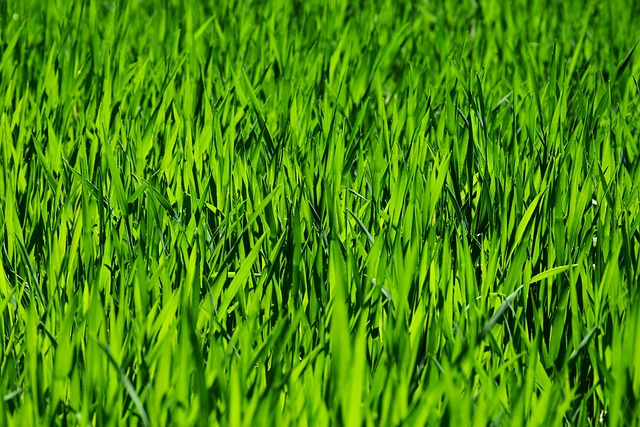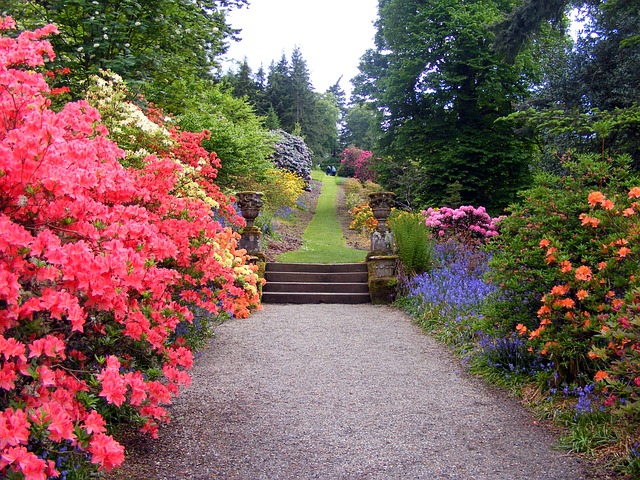Optimize Your Lawn: Mastering Mulching and Edging for Lush Landscapes
Effective lawn care and landscaping hinge on the integration of mulching and edging to promote a healthy, vibrant lawn. Mulching enhances soil fertility, suppresses weeds, conserves moisture, and moderates temperature fluctuations. Choosing the …….

Effective lawn care and landscaping hinge on the integration of mulching and edging to promote a healthy, vibrant lawn. Mulching enhances soil fertility, suppresses weeds, conserves moisture, and moderates temperature fluctuations. Choosing the right type of mulch—organic for gradual nutrient release or inorganic for a consistent appearance—and applying it at an appropriate thickness is key. Edging serves to define lawn edges, preventing grass from encroaching into other areas of the yard, which not only maintains aesthetic clarity but also optimizes resource distribution and upkeep. Regularly refreshing mulch, especially in spring or fall, and maintaining clear edged lines can greatly enhance lawn health, resilience, and overall curb appeal, making your outdoor space both attractive and easier to manage as part of a holistic approach to lawn care and landscaping.
Healthy lawns are the cornerstone of any well-maintained landscape, and mastering the art of mulching and edging is pivotal in this endeavor. This article delves into the nuances of these practices within the realm of Lawn Care and Landscaping, offering insights that will elevate your turf’s health and aesthetics. We’ll explore the benefits of various mulch materials, the impact they have on soil quality, and precise techniques to apply them effectively. Additionally, we’ll guide you through the process of sharp edging that defines lawn boundaries and promotes a manicured look. Integrating these practices into your routine ensures a lush, vibrant lawn that stands out in any neighborhood.
- Understanding the Role of Mulching in Lawn Care and Landscaping
- Types of Mulch Materials and Their Impact on Your Lawn's Health
- Step-by-Step Guide to Effective Mulching Techniques for Healthier Turf
- The Importance of Edging for Lawn Maintenance: Strategies and Best Practices
- Integrating Mulching and Edging in a Comprehensive Lawn Care and Landscaping Routine
Understanding the Role of Mulching in Lawn Care and Landscaping

Mulching plays a pivotal role in maintaining a healthy and vibrant lawn, which is integral to overall landscaping. This organic method involves spreading a layer of material, such as grass clippings, leaves, or wood chips, over the soil on your lawn. The primary benefits of mulching include conserving moisture, regulating soil temperature, reducing weed growth, and enhancing soil fertility. When grass clippings decompose, they return nutrients to the soil, which supports the grass’s growth and vigor. Additionally, a thick layer of mulch can act as a protective barrier against extreme temperatures and sunlight, keeping the soil cooler in summer and warmer in winter. This not only reduces the need for frequent watering but also promotes a more stable environment for the lawn’s root system to thrive.
Incorporating mulching into your regular lawn care and landscaping routine can lead to significant improvements in grass health and appearance. The choice of mulch material should be based on local availability, the desired aesthetics, and the specific needs of your lawn. For instance, finer mulches decompose more slowly and can suppress weeds for longer periods. Implementing a robust mulching strategy complements other lawn care practices, such as proper mowing height and regular fertilization, to create a lush, resilient turf that is both beautiful and sustainable.
Types of Mulch Materials and Their Impact on Your Lawn's Health

Mulching is a critical aspect of effective lawn care, serving as a protective layer over the soil that can significantly influence your lawn’s health and vitality. When selecting mulch materials, homeowners and landscapers have various options, each offering unique benefits. Organic mulches, such as wood chips or straw, break down over time, enriching the soil with nutrients and improving its structure. Composted mulches, derived from decomposed organic matter, not only provide a slow release of essential nutrients but also help retain soil moisture, reducing the need for frequent watering and conserving water. Inorganic mulches like rubber or stone are durable and maintain a consistent surface over time, offering an aesthetic appeal while regulating soil temperature and minimizing weed growth.
Edging plays a complementary role in lawn care by defining the boundary between the lawn and garden beds or hardscape areas. The choice of edging material, whether it’s plastic, metal, rubber, or brick, can affect both the visual appeal and the maintenance requirements of your landscape. A well-maintained edge not only contributes to a neat and manicured look but also prevents grass from encroaching onto paths or flower beds, reducing competition for resources and allowing each area of your yard to thrive independently. Proper mulching and edging practices, when integrated into a comprehensive lawn care and landscaping strategy, can lead to a healthier, more vibrant lawn that withstands various environmental challenges and enhances the overall beauty of your outdoor space.
Step-by-Step Guide to Effective Mulching Techniques for Healthier Turf

Engaging in effective mulching is a cornerstone of robust lawn care and landscaping practices, contributing significantly to the health and vitality of your turf. To begin with, select an appropriate mulch that complements your soil type and the specific needs of your grass. Organic options like composted bark or wood chips not only enhance soil fertility but also conserve moisture and suppress weeds effectively. When applying mulch, ensure a consistent layer around the base of your plants, taking care to avoid over-mulching which can lead to excessive nitrogen depletion and smother your grass.
For the best results, apply fresh mulch annually in the early spring or fall, after leaf removal and before the ground freezes. Use a garden fork to aerate the soil before laying down the mulch, allowing for better moisture penetration and root growth. Edge your flower beds or garden borders with a sharp spade or a half-moon edger to create a clean line that defines the boundary between your lawn and garden areas. This not only promotes a manicured look but also prevents grass from encroaching into these spaces, which can lead to competition for nutrients and water. Regularly maintaining these edges ensures your yard remains well-groomed, contributing to an overall appealing landscape that is the hallmark of quality lawn care and landscaping.
The Importance of Edging for Lawn Maintenance: Strategies and Best Practices

Lawn care and landscaping professionals emphasize the significance of edging for maintaining a well-defined border between your lawn and garden beds or sidewalks. This practice not only enhances the visual appeal of your landscape but also promotes healthy turf growth by preventing grass from encroaching onto walkways, driveways, or flowerbeds, where it would compete with desired plants for resources and sunlight. Edging serves to clarify lawn boundaries, which can improve mowing efficiency and result in a more manicured and uniform appearance.
To achieve optimal results in lawn maintenance through edging, it’s important to select the appropriate tool for your yard’s size and terrain. Manual edgers, such as spade-type edgers, are ideal for smaller yards, offering a more precise cut with less noise and emissions. For larger areas, gas or electric edgers can save time and effort. Regardless of the method chosen, regular edging should be incorporated into your lawn care routine to prevent overgrowth and maintain clear lines between different landscaping elements. Additionally, when edging, it’s crucial to remove any accumulated soil or debris from the edges to ensure a clean separation that accentuates the contours of your garden. Regular maintenance every few weeks during the growing season will help uphold the sharp, defined edges that characterize a professionally maintained lawn. Integrating edging into your overall lawn care and landscaping strategy can significantly enhance the curb appeal of your property while facilitating easier management of your outdoor spaces.
Integrating Mulching and Edging in a Comprehensive Lawn Care and Landscaping Routine

Maintaining a healthy, vibrant lawn requires a multifaceted approach that includes both mulching and edging as key components. Integrating these practices into a comprehensive lawn care and landscaping routine can significantly enhance the appearance and resilience of your turf. Mulching, the application of organic materials like grass clippings, leaves, or wood chips around plants, not only aids in soil enrichment but also serves as a weed suppressant and moisture retainer for the lawn’s vegetation. By decomposing slowly, mulch provides essential nutrients that support plant growth and health. Additionally, it helps maintain an optimal soil temperature, which is crucial for root development and overall lawn vitality.
Edging, another pivotal aspect of effective lawn care and landscaping, delineates the boundary between your lawn and garden beds or walkways with precision. This process sharpens the outline of your lawn, preventing grass from encroaching onto pathways or flowerbeds, and vice versa. A well-defined edge not only contributes to a neater and more manicured appearance but also reduces the spread of grass into undesired areas, thereby minimizing maintenance efforts and promoting a more efficient use of resources. When edging is combined with mulching, the result is a lawn that is both aesthetically pleasing and structurally sound. The combination helps to control growth patterns, conserve soil moisture, and reduce the need for frequent mowing and weeding. Incorporating these practices into your regular lawn care and landscaping routine will yield a more attractive, easier-to-maintain outdoor space that reflects the quality of your commitment to garden upkeep.
Lawns serve as a verdant canvas within our landscapes, demanding attentive care for their health and aesthetics. Mulching and edging stand out as quintessential practices in lawn maintenance, offering tangible benefits for turf vitality and overall appearance. A well-executed mulch layer not only conserves soil moisture but also regulates temperature and mitigates weed encroachment. Selecting the right mulch material is crucial for optimal plant health, as each type offers distinct advantages. Edging, on the other hand, demarcates the lawn’s boundaries with precision, enhancing both the lawn’s formality and the surrounding landscape’s cohesion. Integrating these practices into a routine ensures a manicured lawn that reflects professional landscaping. By adhering to the strategies outlined in this article, homeowners can achieve a thriving lawn that is the envy of the neighborhood, contributing to the broader appeal of their property and reflecting the art of thoughtful lawn care and landscaping.







